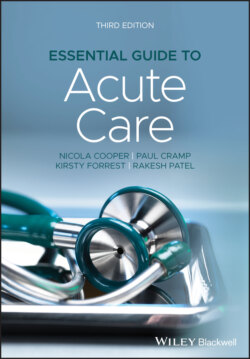Читать книгу Essential Guide to Acute Care - Nicola Cooper - Страница 28
References
Оглавление1 1 Resuscitation Council UK and Intensive Care National Audit and Research Centre (ICNARC). Key statistics from the national cardiac arrest audit 2017/18. https://ncaa.icnarc.org/Home (Accessed October 2019).
2 2 Diem SJ, Lantos JD, Tulsky JA. Cardiopulmonary resuscitation on television. Miracles and misinformation. N Engl J Med 1996; 334: 1578–1582.
3 3 Schein RM, Hazday N, Pena N, Ruben BH. Clinical antecedents to in‐hospital cardiopulmonary arrest. Chest 1990; 98: 1388–1392.
4 4 Franklin C, Matthew J. Developing strategies to prevent in‐hospital cardiac arrest: analysing responses of physicians and nurses in the hours before the event. Crit Care Med 1994; 22: 244–247.
5 5 McQuillan P, Pilkington S, Allan A et al. Confidential enquiry into quality of care before admission to intensive care. BMJ 1998; 316: 1853–1858.
6 6 McGloin H, Adam SK, Singer M. Unexpected deaths and referrals to intensive care of patients on general wards: are some potentially avoidable? J R Coll Physicians 1999; 33: 255–259.
7 7 National Confidential Enquiry Into Patient Outcome and Death. Themes and recommendations common to all hospital specialties. NCEPOD, 2018. https://www.ncepod.org.uk/CommonThemes.html (Accessed October 2019).
8 8 Goldhill DR, McNarry AF. Physiological abnormalities in early warning scores are related to mortality in adult inpatients. Br J Anaesth 2004; 92(6): 882–884.
9 9 Subbe CP, Kruger M, Rutherford P, Gemmel L. Validation of a modified early warning score in medical admissions. Q J Med 2001; 94: 521–526.
10 10 Ball C, Kirkby M, Williams S. Effect of the critical care outreach team on patient survival to discharge from hospital and readmission to critical care: non‐randomised population based study. BMJ 2003; 327: 1014–1017.
11 11 Aneman A, Frost SA, Parr MK, Hillman KM. Characteristics and outcomes of patients admitted to ICU following activation of the medical emergency team: impact of introducing a two‐tier response system. Crit Care Med 2015; 43(4): 765–773.
12 12 Royal College of Physicians. National Early Warning Score (NEWS) 2: Standardising the assessment of acute illness severity in the NHS. Updated report of a working party. London: RCP, 2017.
13 13 Safar P. Critical care medicine – quo vadis? Crit Care Med 1974; 2: 1–5.
14 14 Audit Commission. Critical to success – the place of efficient and effective critical care services within the acute hospital. London, October 1999.
15 15 Department of Health. Comprehensive Critical Care – a review of adult critical care services. London, May 2000.
16 16 Lyons RA, Wareham K, Hutchings HA et al. Population requirement for adult critical care beds: a prospective quantitative and qualitative study. Lancet 2000; 355(9024): 595–598.
17 17 Royal College of Physicians of London. Working party report on the interface between acute general [internal] medicine and critical care. London, May 2002.
18 18 Jones R. Trends in critical care bed numbers in England. Br J Healthc Manag 2018; 24(10): 516–517.
19 19 McNeill G, Bryden D. Do either early warning systems or emergency response teams improve hospital patient survival? A systematic review. Resuscitation 2013; 84(12): 1652–1667.
20 20 Office for National Statistics. Changes in the older resident care home population between 2001 and 2011. ONS, 2014. https://www.ons.gov.uk (Accessed October 2019).
21 21 Khan I, Ridley S. Intensive care – who benefits?. JICS 2014; 15(4): 297–303.
22 22 Anderson FH, Flaatten H, Klepstad P, Romild U, Kvale R. Long‐term survival and quality of life after intensive care for patients aged 80 years of age or older. Ann Intensive Care 2015; 5(13). DOI https://doi.org/10.1186/s13613‐015‐0053‐0.
